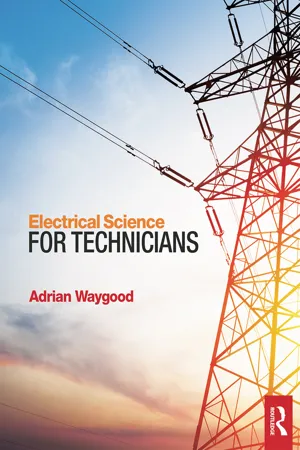
This is a test
- 430 pages
- English
- ePUB (mobile friendly)
- Available on iOS & Android
eBook - ePub
Electrical Science for Technicians
Book details
Book preview
Table of contents
Citations
About This Book
An indispensable resource for electrical technicians and trainees, Electrical Science for Technicians walks readers through the subject in a logical order, providing a historical overview alongside modern electrical theory and practice. You will be guided through the subject in a topic by topic manner with each section building upon the one that came before it. By adding context to the principles of electrical science they become easier to both understand and remember, providing a background in the subject that will remain with you for life.
- Fully aligned to the 17th edition of the wiring regulations
- Topic-based approach ensures suitability for both technicians and students
- Clear objectives outlined at the start and revisited at the end of each chapter as a checklist allow readers to check their learning before moving on
Frequently asked questions
At the moment all of our mobile-responsive ePub books are available to download via the app. Most of our PDFs are also available to download and we're working on making the final remaining ones downloadable now. Learn more here.
Both plans give you full access to the library and all of Perlego’s features. The only differences are the price and subscription period: With the annual plan you’ll save around 30% compared to 12 months on the monthly plan.
We are an online textbook subscription service, where you can get access to an entire online library for less than the price of a single book per month. With over 1 million books across 1000+ topics, we’ve got you covered! Learn more here.
Look out for the read-aloud symbol on your next book to see if you can listen to it. The read-aloud tool reads text aloud for you, highlighting the text as it is being read. You can pause it, speed it up and slow it down. Learn more here.
Yes, you can access Electrical Science for Technicians by Adrian Waygood in PDF and/or ePUB format, as well as other popular books in Technology & Engineering & Electrical Engineering & Telecommunications. We have over one million books available in our catalogue for you to explore.
Information
CHAPTER | 1 |
Solving complex circuits: network theorems
Objectives
On completion of this chapter you should be able to:
1. recognise a complex circuit.
2. apply ‘sense arrows’ to complex circuits.
3. identify junctions (‘nodes’) and loops (‘meshes’) in complex circuits.
4. recognise complex circuits to which the following ‘network analysis’ techniques may be applied:
a. Kirchhoff’s Loop Equation method.
b. Superposition Theorem method.
c. Delta-Star/Star-Delta Transformation method.
d. Thévenin’s Theorem method.
5. define Kirchhoff’s ‘Current Law’ and ‘Voltage Law’.
6. solve complex circuits using Kirchhoff’s ‘Loop Analysis’ method.
7. solve complex circuits, using the ‘Superposition Theorem’.
8. solve complex circuits, using the ‘Delta-Star/Star-Delta Transformation’ method.
9. solve complex circuits, using ‘Thévenin’s Theorem’.
Introduction
In the companion book, An Introduction to Electrical Science, we learnt that electrical circuits are categorized according to the way in which their various components are connected relative to each other.
And we learnt that there are four such categories as shown in Figure 1.1. We also learnt that the term, ‘complex circuit’, is nothing more than a category into which we can place any circuit that isn’t connected in ‘series’, ‘parallel’, or ‘seriesparallel’. Used in this context, then, the term ‘complex’ doesn’t mean ‘complicated’, although many complex circuits are indeed complicated! ‘Complex circuits’ are often referred to as ‘networks’, so the analysis of complex circuits is often referred to as ‘network analysis’.

Figure 1.1
A basic example of a circuit within each of these categories is shown in Figures 1.2a–d. We need to bear in mind, however, that there are countless variations of the examples of series-parallel and complex connections having various degrees of difficulty.
We also learnt how to solve series, parallel, and series-parallel circuits. By ‘solve’, we mean determining the equivalent resistance of the circuit, as well as the currents through, and the voltage drops across, each of their components.
Unfortunately, the techniques we use to solve series, parallel, and series-parallel circuits cannot be used to solve complex circuits. Well … this is only partly true, because we may need to use those techniques to simplify parts of a complex circuit,...
Table of contents
- Cover
- Half Title
- Title Page
- Copyright Page
- Dedication
- Table of Contents
- Foreword
- The author
- Introduction
- 1 Solving complex circuits: network theorems
- 2 Review of series and parallel a.c. circuits
- 3 Resolving phasors
- 4 Series-parallel a.c. circuits
- 5 Solving a.c. circuits using symbolic notation
- 6 Solving balanced and unbalanced three-phase circuits, using symbolic notation
- 7 Electrical measurements
- 8 Measuring three-phase power
- 9 Transformers 1: construction
- 10 Transformers 2: theory
- 11 Transformers 3: connections
- 12 D.C. generators
- 13 D.C. motors
- 14 Synchronous generators
- 15 Three-phase induction motors
- 16 Single-phase motors
- 17 A.C. motor starters
- 18 Electric lighting
- Index